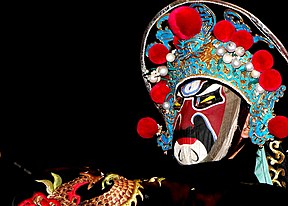User:Aza24/The arts
- A tambourine player at a traditional debaa dance festival in Mayotte
- Still Life with Profile of Laval by Paul Gauguin, 1886
- The title page of Shakespeare's sonnets in a 1609 edition by Thomas Thorpe
- Las Lajas Shrine, Nariño Department, Colombia
- A Bian Lian performer.
The arts are a wide range of human practices which use skill or imagination for the creation of human expression, storytelling and cultural participation.[1][2][3] In the broadest sense, categories of the arts may include the decorative arts, graphic arts, literary arts, performing arts, plastic arts and visual arts.[2]
Lorem ipsum dolor sit amet, consectetur adipiscing elit, sed do eiusmod tempor incididunt ut labore et dolore magna aliqua. Ut enim ad minim veniam, quis nostrud exercitation ullamco laboris nisi ut aliquip ex ea commodo consequat. Duis aute irure dolor in reprehenderit in voluptate velit esse cillum dolore eu fugiat nulla pariatur. Excepteur sint occaecat cupidatat non proident, sunt in culpa qui officia deserunt mollit anim id est laborum.
Lorem ipsum dolor sit amet, consectetur adipiscing elit, sed do eiusmod tempor incididunt ut labore et dolore magna aliqua. Ut enim ad minim veniam, quis nostrud exercitation ullamco laboris nisi ut aliquip ex ea commodo consequat. Duis aute irure dolor in reprehenderit in voluptate velit esse cillum dolore eu fugiat nulla pariatur. Excepteur sint occaecat cupidatat non proident, sunt in culpa qui officia deserunt mollit anim id est laborum.
Terminology[edit]
The arts are a broad range of creative activity and most reference works stress their use of skill or imagination.[1][2][3] On trying define such subjects, the anthropologist Evelyn Payne Hatcher remarked that they are "not definable in the way objects can be defined; there are no right or wrong definitions, just more or less usual or useful ones".[4] The arts are often created with aesthetic principles or values in mind, formally evaluated as aesthetic taste.[1] Products of artistic creation may include environments, experiences and objects.[2][a]
Since the arts is a count noun and essentially the plural of art, the two are occasionally interchangeable.[7] Although without context or modification, art typically refers to solely the visual arts, whereas the arts is always a broader group, including some kind of performative and literary pursuits as well.[7][b] The historian Paul Oskar Kristeller explains that "although the terms "Art," " Fine Arts " or " Beaux Arts " are often identified with the visual arts alone, they are also quite commonly understood in a broader sense."[9] The Fine Arts in particular are a more specific subset rooted in the 19th-century Western Enlightenment.[10][11] They are judged made for aesthetic and intellectual purposes.
Although, the 1911 Encyclopædia Britannica defined them as five practices: architecture, sculpture, painting, music and poetry, but they have [10]
[craft] Craft sometimes comes under the guise of decorative arts specifically Fariello|p=18 https://www.google.com/books/edition/Objects_and_Meaning/7YShOpQEuygC?hl=en&gbpv=1&bsq=%22art%20and%20craft%22
[fine arts] Fine arts
https://www.jstor.org/stable/546447 (liberal arts)
History[edit]
The arts are typically considered as having emerged in the Paleolithic period of prehistory, although whether this was the Middle Paleolithic (c. 300–50 years ago (ka)) or the Upper Paleolithic (c. 50–12 ka) is disputed.[12][13] Evidence for arts during the earlier Middle Paleolithic controversial, as the emergence of Behavioral modernity—the capacity for distinguishable human cognition—is traditionally dated to the later Upper Paleolithic.[13] Proposed objects such as the Venus of Tan-Tan and Divje Babe flute have been intensely debated as genuine artifacts or objects formed from natural events or formed by non-human animals.[12][14] From the Upper Paleolithic, the earliest visual arts are cave paintings and small female sculptures known as Venus figurine.[15][13] The oldest of these are cave paintings of pigs in Sulawesi, Indonesia (43,900 BP),[16][17] and the Venus of Hohle Fels of its namesake cave in Swabian Jura, Germany (35,000 BP).[18][19] The earliest confirmed traces of music are from the same region of Germany: prehistoric bone flutes found in caves, the oldest being three from the Geissenklösterle cave (c. 43,150–39,370 BP).[20] The earliest extant literature appears much in c. 2600 BCE with Sumerian cuneiform tablets from Abu Salabikh such as the Instructions of Shuruppak and Kesh temple hymn.[21] Prehistoric evidence for other forms of art is rarer, although children's' footprints from the Cave of the Trois-Frères may indicate dance during a ritual.[22][23] The arts were probably used for shamanistic rituals, which may have been for prehistoric religion, regulation of emotions, or social bonding.[24][25]
Like the prehistoric period, the arts of the ancient world were closely connected to each other, and usually produced or performed for a specific commission or event.[26] Artists or performers were usually of low status and considered craftsman, who often had no need to strive for particular originality.[26]
Because of their practical motivations [considered low status etc] or "an artisan rather than an artist" as described by Martindale [27] artisan also: https://archive.org/details/artascultureintr0000hatc/page/242/mode/2up?view=theater
medieval (p. 58) https://archive.org/details/aestheticsstudyo00feib/page/58/mode/2up?view=theater&q=%22the+arts%22
ren https://archive.org/details/artistictheoryin0000blun/page/48/mode/2up?view=theater
modern propoganda https://www.jstor.org/stable/850880?seq=2
Conceptual history[edit]
Function[edit]
"The arts occur overwhelmingly in contexts of group assembly and deal with issues of collective importance. In traditional cultures... "[29]
Overview[edit]
Historiography[edit]
Periodization[edit]
The arts[edit]
Censorship[edit]
Arts critique[edit]
Refer back to[edit]
"Rather, the recorded history of the arts reveals that far from being divorced from political, religious, and economic concerns, they have long been intimately interconnected. Vested with the explicit responsibility in many countries for cultivating the arts, and educating young and old alike in the arts, arts educators" – https://www.jstor.org/stable/pdf/10.2979 (p. 16)
Evolutionary change https://archive.org/details/artascultureintr0000hatc/page/168/mode/2up?view=theater
References[edit]
Notes[edit]
- ^ The arts scholar Ellen Dissanayake has specified these categorizes as: art as objects, art as a "quality of beauty", art as an "indicator of craftsmanship or creativity" and art as a "process of performance".[5] In a a longer list, the philosopher of art Denis Dutton variously classifies it as "direct pleasure", "skill and virtuosity", "style", "novelty and creativity", "criticism", "representation", "special focus", "expressive individuality", "emotional saturation", "intellectual challenge", "traditions and institutions", "imaginative experience".[6]
- ^ The OED Online explains that "The unmodified mass noun [art] is normally understood as referring to the visual arts; however, it may sometimes to extended to include music, literature, dance, drama, etc., though the plural form arts is frequently used to indicate a broader range of creative activities"[8]
Citations[edit]
- ^ a b c OED, § I.7.
- ^ a b c d Britannica 2023.
- ^ a b Merriam-Webster.
- ^ Hatcher 1985, p. 241.
- ^ Brown 2021, pp. 3–4.
- ^ Dutton 2009, pp. 52–59.
- ^ a b OED, § I.7, I.8a.
- ^ OED, § I.8a.
- ^ 1951, p. 497.
- ^ a b Brown 2021, p. 3.
- ^ Clowney 2011, p. 309.
- ^ a b Fancourt 2017, p. 3.
- ^ a b c Morriss-Kay 2009, § "How, when and where was art first created?".
- ^ Morley 2013, pp. 38–39.
- ^ Fancourt 2017, pp. 3–4.
- ^ Brumm et al. 2020.
- ^ Ferreira 2021.
- ^ Conard 2009, p. 248.
- ^ Wilford 2009.
- ^ Morley 2013, pp. 42–43.
- ^ Black et al. 2006, pp. 275, 325.
- ^ Fancourt 2017, p. 5.
- ^ Pastoors et al. 2021.
- ^ Fancourt 2017, pp. 4–6.
- ^ Morriss-Kay 2009, § "Shamanism and parietal art".
- ^ a b du Cros & Jolliffe 2014, p. 16.
- ^ Martindale 1990, p. 16.
- ^ Brown 2021, pp. 7–8.
- ^ Brown 2021, p. 54.
- ^ Vann 2023.
- ^ Kozbelt 2021.
- ^ Martindale 1990.
Sources[edit]
- Books
- Black, Jeremy; Cunningham, Graham; Robson, Eleanor; Zólyomi, Gábor (2006). The Literature of Ancient Sumer. Oxford: Oxford University Press. ISBN 978-0-19-929633-0.
- Brown, Steven (2021). The Unification of the Arts: A Framework for Understanding What the Arts Share and Why. Oxford: Oxford University Press. doi:10.1093/oso/9780198864875.001.0001. ISBN 978-0-19-886487-5.
- du Cros, Hilary; Jolliffe, Lee (2014). The Arts and Events. New York: Routledge. ISBN 978-1-135-04141-0.
- Donoghue, Denis (1983). The Arts Without Mystery. Boston: Little, Brown and Company. ISBN 978-0-316-18981-1.
- Dutton, Denis (2009). The Art Instinct: Beauty, Pleasure, & Human Evolution. Oxford: Oxford University Press. ISBN 978-0-19-953942-0.
- Fancourt, Daisy (2017). Arts in Health: Designing and Researching Interventions. Oxford: Oxford University Press. ISBN 978-0-19-879207-9.
- Hatcher, Evelyn Payne (1985). Art As Culture: An Introduction to the Anthropology of Art. Lanham: University Press of America. ISBN 978-0-89789-628-3.
- Kapferer, Judith, ed. (2008). The State and the Arts: Articulating Power and Subversion. New York: Berghahn Books. ISBN 978-1-84545-578-1.
- Martindale, Colin (1990). The Clockwork Muse: The Predictability of Artistic Change. New York: Basic Books. ISBN 978-0-465-01186-5.
- Morley, Iain (2013). The Prehistory of Music: Human Evolution, Archaeology, and the Origins of Musicality. Oxford: Oxford University Press. ISBN 978-0-19-923408-0.
- Pastoors, Andreas; Lenssen-Erz, Tilman; Ciqae, Tsamgao; Kxunta, Ui; Thao, Thui; Bégouën, Robert; Uthmeier, Thorsten (2021). "Episodes of Magdalenian Hunter-Gatherers in the Upper Gallery of Tuc d'Audoubert (Ariège, France)". In Pastoors, Andreas; Lenssen-Erz, Tilman (eds.). Reading Prehistoric Human Tracks. New York: Springer Publishing. pp. 211–249. ISBN 978-3-030-60406-6.
- Perl, Jed (2022). Authority and Freedom: A Defense of the Arts. New York: Knopf Doubleday Publishing Group. ISBN 978-0-593-32005-1.
- Sayre, Henry M. (2005). "Arts". In Horowitz, Maryanne Cline (ed.). New Dictionary of the History of Ideas (PDF). Vol. 1. New York: Charles Scribner's Sons. pp. 136–143. ISBN 978-0-684-31378-8.
- Shiner, Larry (2003). The Invention of Art: A Cultural History. Chicago: University of Chicago Press. ISBN 978-0-226-75342-3.
- Articles
- Brumm, Adam; Oktaviana, Adhi Agus; Burhan, Basran; Hakim, Budianto; Lebe, Rustan; Zhao, Jian-Xin; Sulistyarto, Priyatno Hadi; Ririmasse, Marlon; Adhityatama, Shinatria; Sumantri, Iwan; Aubert, Maxime (1 January 2020). "Oldest cave art found in Sulawesi". Science Advances. 7 (3): eabd4648. Bibcode:2021SciA....7.4648B. doi:10.1126/sciadv.abd4648. ISSN 2375-2548. PMC 7806210. PMID 33523879.
- Clowney, David (2011). "Definitions of Art and Fine Art's Historical Origins". The Journal of Aesthetics and Art Criticism. 69 (3): 309–320. doi:10.1111/j.1540-6245.2011.01474.x. ISSN 0021-8529. JSTOR 23883666.
- Conard, Nicholas J. (2009). "A female figurine from the basal Aurignacian of Hohle Fels Cave in southwestern Germany". Nature. 459 (7244): 248–252. Bibcode:2009Natur.459..248C. doi:10.1038/nature07995. PMID 19444215. S2CID 205216692.
- Ferreira, Becky (13 January 2021). "Pig Painting May Be World's Oldest Cave Art Yet, Archaeologists Say - The depiction of the animal on an Indonesian island is at least 45,500 years old, the researchers say". The New York Times. Retrieved 14 January 2021.
- Honderich, Ted, ed. (2006). "Performing Arts". The Oxford Companion to Philosophy. Oxford: Oxford University Press. doi:10.1093/acref/9780199264797.001.0001. ISBN 978-0-19-926479-7.
- Kozbelt, Aaron (24 November 2021). "The Aesthetic Legacy of Evolution: The History of the Arts as a Window Into Human Nature". Frontiers in Psychology. 12. doi:10.3389/fpsyg.2021.787238. PMC 8651700. PMID 34899539.
{{cite journal}}: CS1 maint: unflagged free DOI (link) - Morriss-Kay, Gillian M (6 November 2009). "The evolution of human artistic creativity". Journal of Anatomy. 216 (2): 158–176. doi:10.1111/j.1469-7580.2009.01160.x. PMC 2815939. PMID 19900185.
- Vann, Richard T. (24 March 2023). "Historiography | Definition, History, Branches, & Methodology". Encyclopædia Britannica. Chicago: Encyclopædia Britannica, Inc. Retrieved 10 July 2023.
- Wilford, John Noble (13 May 2009). "Full-Figured Statuette, 35,000 Years Old, Provides New Clues to How Art Evolved". The New York Times. Retrieved 23 October 2013.
- "The arts | Creative Expression, Visual Arts & Performing Arts". Encyclopædia Britannica. Chicago: Encyclopædia Britannica, Inc. 10 February 2023. Retrieved 10 July 2023.
- Online
- "art, n.1 meanings, etymology and more". OED Online. Oxford: Oxford University Press. Retrieved 20 July 2021.(subscription required)
- "Definition of the arts". Merriam-Webster. Archived from the original on 1 June 2017. Retrieved 14 May 2017.
Further reading[edit]
- Tusa, John (2014). Pain in the Arts. London: Bloomsbury Publishing. ISBN 978-0-85772-377-2.





